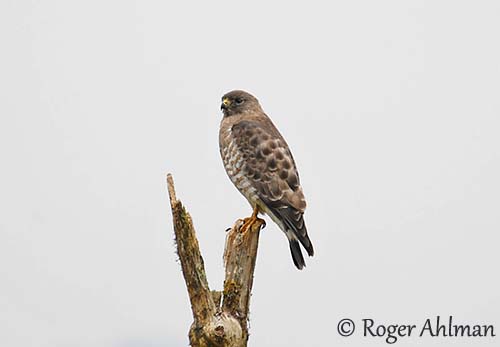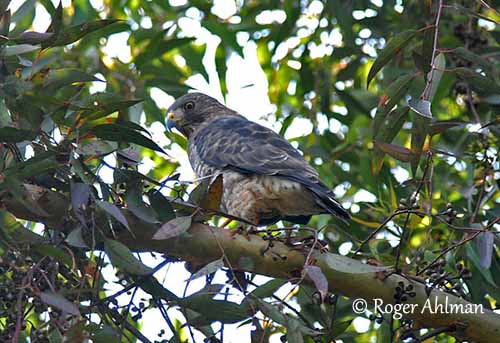
Fr: Petite buse
Ang: Broad-winged Hawk - Broadwing
All: Breitflügelbussard
Esp: Busardo Aliancho
Ita: Poiana alilarghe
Nd: Breedvleugelbuizerd
Sd: Bredvingad vråk
Port: Gavião-de-asa-larga
Photographers:
Roger Ahlman
Pbase Galleries Peru and Ecuador
John Anderson
John Anderson Photo Galleries
Alfredo Colón
Puerto Rico Wildlife
Ken Havard
My Bird Gallery & Flickr gallery 1 & Flickr gallery 2
Text by Nicole Bouglouan
Sources:
HANDBOOK OF THE BIRDS OF THE WORLD Vol 2 by Josep del Hoyo-Andrew Elliot-Jordi Sargatal - Lynx Edicions - ISBN: 8487334156
HAWKS, EAGLES AND FALCONS OF NORTH AMERICA by Paul A. Johnsgard - Smithsonian Institution Press - ISBN: 1560989467
A GUIDE TO THE BIRDS OF MEXICO AND NORTHERN CENTRAL AMERICA by Steve N. G. Howell, Sophie Webb - Oxford University Press - ISBN: 0198540124
A GUIDE TO THE BIRDS OF COLOMBIA by Steven L. Hilty and William L. Brown - Princeton University Press – ISBN 069108372X
BirdLife International (BirdLife International)
Animal Diversity Web (University of Michigan Museum of Zoology)
All About Birds (Cornell Lab of Ornithology)
Global Raptor Information Network - Working to Conserve Birds of Prey in nature
What Bird-The ultimate Bird Guide (Mitchell Waite)
Wikipedia, the free encyclopaedia
Broad-winged Hawk
Buteo platypterus
Accipitriformes Order – Accipitridae Family
INTRODUCTION:
The highly migratory Broad-winged Hawk is the smallest North American hawk of genus Buteo. This species is not globally threatened, although declines are reported, due to degradation of the breeding range by forest fragmentation.
The Broad-winged Hawk is a long-distance migrant, with birds breeding in Canada and wintering in Brazil. They travel in huge flocks of hundreds to thousands of birds. However, some subspecies are resident in Cuba, Puerto Rico and several islands in the West Indies.
DESCRIPTION OF THE BIRD:
Biometrics:
Length: 38-46 cm
Wingspan: 86-100 cm
Weight: M: 325-385 g – F: 395-560 g
The adult has brown to fuscous-black upperparts, including crown, nape, scapulars, back, rump and upperwing-coverts. The uppertail-coverts are brown, tipped with white, whereas the rectrices are blackish. We can see three whitish bands with the broader in the middle of the tail, and two narrower bands at the base and tip.

On the underparts, chin and throat are white, sometimes washed buff. Rest of underparts is variably whitish, with the breast streaked and barred with dull rufous-brown, and upper belly, body sides and flanks are similar to breast with narrower bars. The lower belly is white or slightly marked with brownish. The undertail-coverts are white. The thighs show paler and narrower brown marks than the body sides. The underwing is whitish with sparse brown spots and stripes on the underwing-coverts.
On the head, crown and nape are brown to fuscous-black. Cheeks are brown to fuscous, and a broad darker moustache runs downwards across the cheeks. The lores are whitish to buffy-white. The light-morph adult may show a narrow buffy-white forehead line.
The bill is slate grey to black with greenish-yellow cere. The eyes are brownish-yellow to hazel. Legs and feet are pale yellow with bluish-black talons.
The adult of dark morph is very rare and occurs mainly in W Canada (Alberta). It resembles light morph adult, but the feathers of the neck sides and upper back are edged cinnamon or brown. On the underparts, the marks are more rufescent.
Both sexes are similar, but the female is slightly larger than male.
The juvenile resembles adults but it has pale feather edges and variable dark marks on the breast, but not rufous bars. The tail shows 5-6 dark brown bars.
The bill is black with yellow cere. The eyes are pale grey. Legs and feet are greenish-yellow. The nearly adult plumage is attained during the second fall of its life.
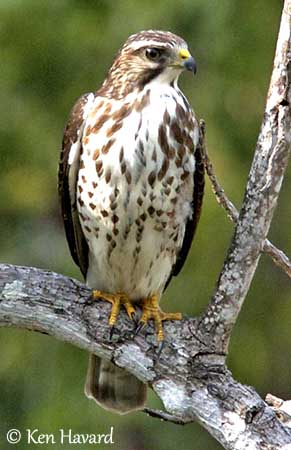
SUBSPECIES AND RANGE:
The Broad-winged Hawk has six recognized subspecies which differ on pattern and intensity of coloration of the underparts.
B.p. platypterus (here described and displayed) is found in SC and SE Canada and E USA. It winters in S Florida, and from S Mexico through Central and South America to E Peru, N Bolivia and W Brazil.
B.p. cubanensis occurs in Cuba where it is resident.
B.p. brunnescens is found in Puerto Rico where it is resident. It is the darkest race and it is smaller than nominate.
B.p. insulicola occurs in Antigua (N Lesser Antilles).
B.p. rivierei is found in Dominica, Martinique and St Lucia (C Lesser Antilles).
B.p. antillarum occurs in S Lesser Antilles (St Vincent, Grenadine, Grenada) and Tobago.
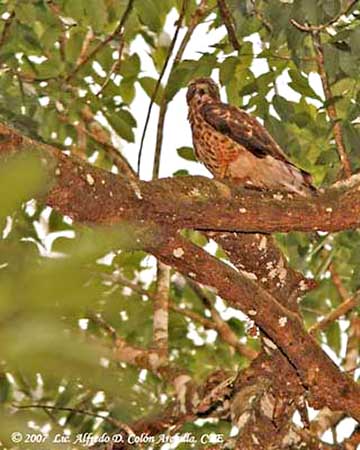
HABITAT:
The Broad-winged Hawk is a forest-dwelling raptor. It can be found in most of the forested areas of E USA and S Canada, E to British Columbia. It occurs in dry to wet deciduous, mixed and occasionally coniferous forests. It often hunts at wetland edges and road openings. It nests in fairly continuous woodlands with swamps, ponds and lakes, at some distance from the nest-site, between 70 and 150 metres.
On the wintering grounds, this raptor is found in deciduous and mixed tropical forests in Central and South America.
CALLS AND SONGS: SOUNDS BY XENO-CANTO
The Broad-winged Hawk’s alarm call is a monotonous two-syllable whistle “pee-wee”, both notes fairly high-pitched for a hawk. A thin, drawn-out whistle, high-pitched too, is given from perch and in flight “eeeeeeu” or “ssiiiiiiu”.
BEHAVIOUR IN THE WILD:
The Broad-winged Hawk feeds on a wide variety of preys such as numerous species of small mammals from mouse to small rabbit, several bird species to size of a small grouse, and reptiles, amphibians and invertebrates including grasshoppers and dragonflies.
Insects and other arthropods, as well as lizards and frogs, are largely fed on the wintering areas where individual foraging territories could be maintained during the season.
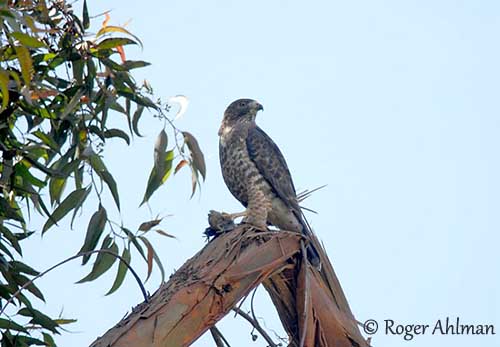
The Broad-winged Hawk hunts from perch or concealed among tree foliage, but mainly at the edge of opening and clearing. It can also be seen perched on more exposed poles and electric power wires. But it usually searches for preys in flight, fairly high at treetop level. It also performs soaring and hovering followed by swooping onto the prey.
During the breeding season, the Broad-winged Hawk performs typical Buteo courtship displays. The birds use soaring and swooping behaviour to advertise the territory, while uttering loud typical whistles. They are monogamous.
During the copulation which occurs in the vicinity of the nest, the male utters a two-toned courtship call. The pair-bonds are probably maintained for more than a single season, but more information is needed. They usually build a new nest when they return from migration, but often in the same territory.
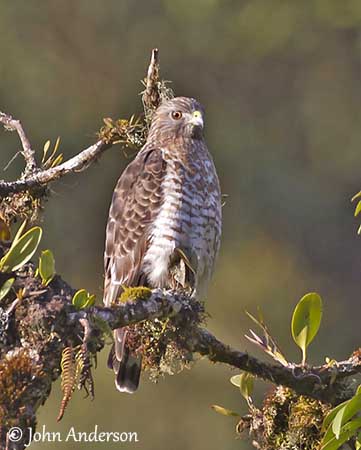
The Broad-winged Hawk breeding in N America migrates southwards to Central and South America for wintering. The birds living in Cuba, Puerto Rico and several islands in the West Indies are resident.
This raptor is often seen soaring on flattish wings slightly pressed forwards, and spread or partially spread tail. It uses thermal currents when migrating, in order to conserve energy and to fly faster. It avoids large water crossings.
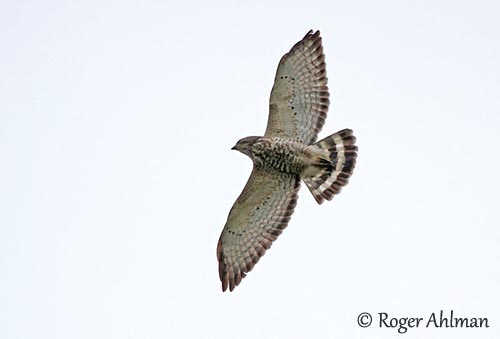
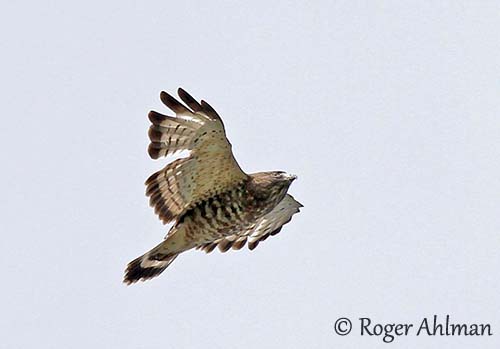
REPRODUCTTION OF THIS SPECIES:
The breeding season takes place between March and July. The Broad-winged Hawk is solitary nester. The nest is placed in a crotch next to the trunk of a deciduous tree, or sometimes in conifer. The nest is about 6-14 metres above the ground. It is made with sticks and lined with greenery and bark chips. This raptor may sometimes use abandoned nests of Corvidae or squirrels.
The female lays 2-4 eggs. She usually incubates during 28-31 days, while the male is hunting and brings food to the female. At hatching, the chicks have white down and black bill. The male still hunts for preys and the female feeds the chicks during about one month. They are still fed for 50 days more after leaving the nest. The young birds are able to make short flights at six weeks old. They remain a few hundred metres from the nest for some weeks. They will be sexually mature between one and two years of age.
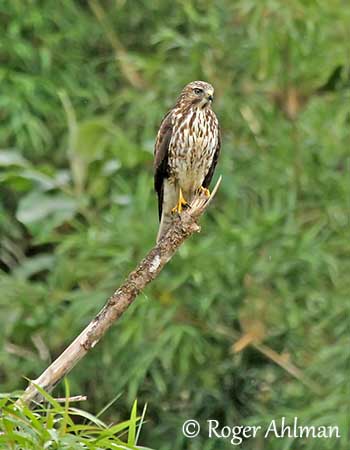
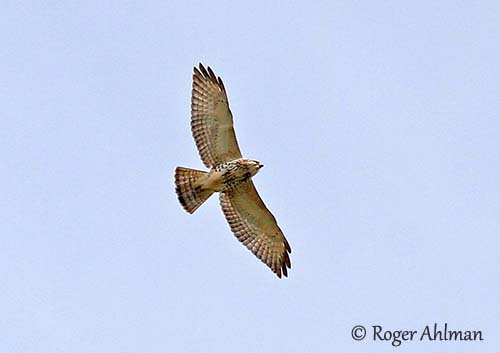
PROTECTION / THREATS / STATUS:
The Broad-winged Hawk is common throughout its wide range. The population of the Caribbean is threatened by degradation of the habitat and loss of primary forest.
The North American population is estimated at about 1,000,000 individuals. The race “brunnescens” from Puerto Rico is very rare with only 124 birds at three locations.
But currently, the Broad-winged Hawk is evaluated as Least Concern.
